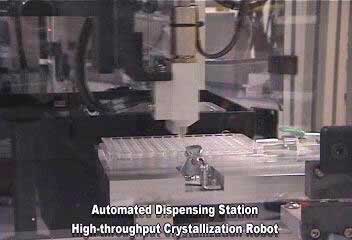Better Tools and Better Knowledge for Structural Genomics
The Joint Center for Structural Genomics
(JCSG;
http://www.jcsg.org) was established in 1999, with institutional commitments from The Scripps Research Institute (TSRI), the University of California at San Diego (UCSD), Stanford Synchrotron Radiation Laboratory (SSRL), and the Genomics Institute of the Novartis Research Foundation (GNF). Its mission has been to establish a robust and scalable protein structure determination pipeline that will form the foundation for a large-scale cost effective production center for structural genomics. The primary focus of the JCSG has been the development and implementation of innovative technologies to address many of the traditional bottlenecks encountered in structural biology research. The JCSG pipeline is based on the development of high-throughput approaches for every experimental and computational step in the structural genomics process. The JCSG has pioneered development of technologies for many steps from gene to structure which have been integrated into a HT pipeline that includes all of the steps from target selection, parallel expression, protein purification, automated crystallization trials, automated crystal screening, structure determination, validation, and publication (
Fig. 1; Lesley et al,(2002) PNAS. 99:11664-11669).

Fig. 1: The JCSG HT protein structure determination pipeline.

Fig. 2. The high-throughput bacteria fermentation system.
For high-throughput large-scale protein expression in E. coli, parallel 96-tube fermentation systems have been developed (Fig. 2) that permit cultures to reach high cell densities (OD600=20–30) in 8 h (U.S. Published Patent Application 2002/0146818). This system, which was developed in collaboration with the Genomics Institute of the Novartis Research Foundation (GNF; http://www.gnf.org), has provided an average of 7 milligrams of protein per tube for the soluble proteins evaluated to date. Issues of scalability are minimal since multiple cultures (up to 96) can be dedicated to those proteins that are expressed at low levels. For moderately well expressed protein, this instrument enables the generation of sufficient quantities of biomass for the processing of several hundred clones per week. Protein purification from E. coli has been largely automated using GNFuge (Fig. 3), a robot developed at GNF (U.S. Published Patent Applications 2002/0132286, 2002/0132354, 2002/0164653). The fully automated, GNFuge harvests, sonicates, centrifuges, and aspirates 96 bacterial cultures in parallel. In addition, it facilitates fully automated affinity purification of tagged proteins from the resulting lysates and for insoluble proteins.


Fig. 4. Agincourt robot system. (Left) The crystallization system developed at GNF located at Syrrx (http://www.syrrx.com) consists of a number of stations arranged around a central robotic arm. The precision arm shuttles the plates from a well-filling station that can put any combination of 96 solutions into each well as needed, to a mixing station, a well-dispensing station, a protein-dispensing station, a taping station to seal the plates, and finally a stacker unit that then is transferred to the imaging fort (see fig. 6). (Right) Close-up of the protein-dispensing station. The protein is kept on the cooling blocks in the rear until needed.
High-throughput protein crystallization is performed using Agincourt, a fully integrated second-generation robotic system (Fig. 4). This system, which is based on the T2K system developed at Lawrence Berkeley National Laboratory, is capable of dispensing "on the fly" sitting drops ranging in volume from 20 nl to 1 µl using a Cartesian Technologies SynQuad dispensing robot. The system sets up a standard sitting-drop vapor diffusion experiment using a commercially available 96-well plate that is sealed with clear tape. Under current operating parameters, Agincourt can set up a 96-well sitting-drop plate every 2 min, giving it a maximum throughput of 2880 crystallization experiments per hour when setting up 50-nl crystallization experiments.


Fig. 5. Protein crystal incubator and imager fort. The system stores stacks of plates on either side of a central gantry arm. Each stack can be taken to one of two imagers by the central arm to be imaged on a number of different schedules. A typical schedule would be days 1, 3, 7, 14, and 21.
Crystallization plates are then transferred the Syrrx Imaging and Storage Forts (Fig. 5). This gantry-assembly storage unit houses a crystal imager that can automatically capture and process 138,000 images per day at both 4 °C and 20 °C. Drops are imaged using an OptiMag Veeco-Oasis 1700 imager connected over a gigabit network to an image file server. The server processes and manages the image files and links them to the corresponding experimental data in a relational database. This system architecture decouples imaging and analysis to achieve maximum throughput, imaging 96 individual wells of a crystallization plate, in less than 1 minute.
